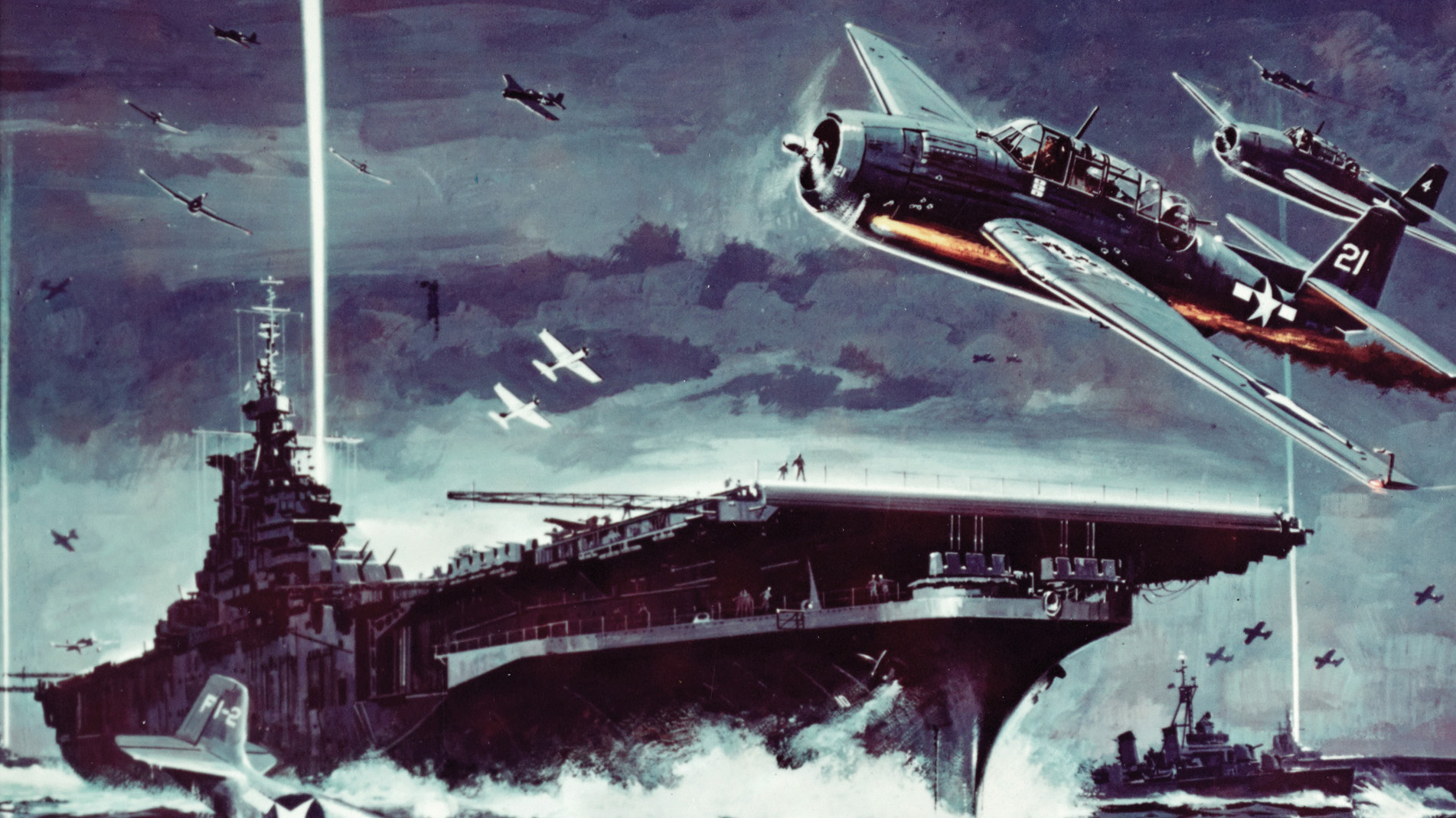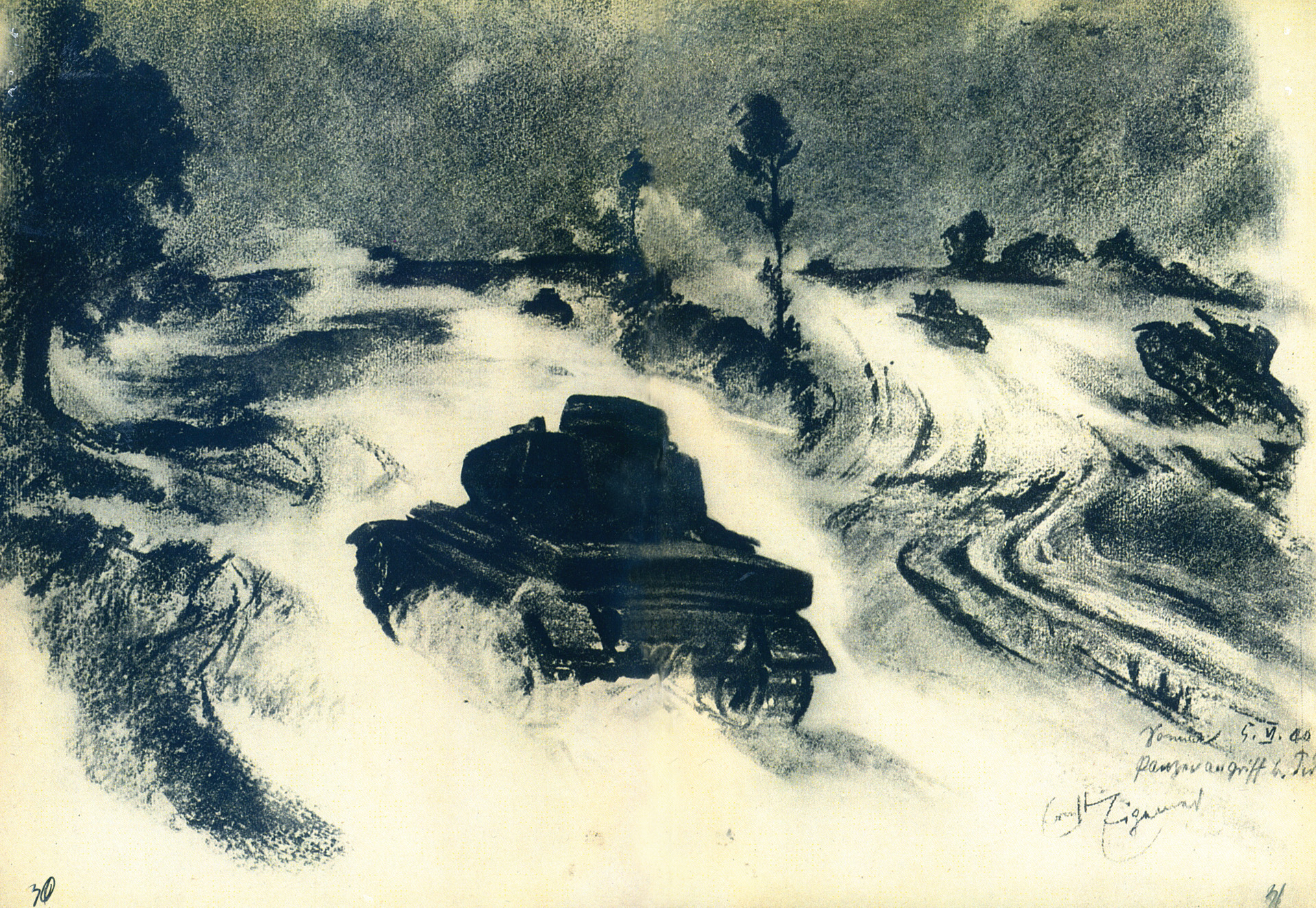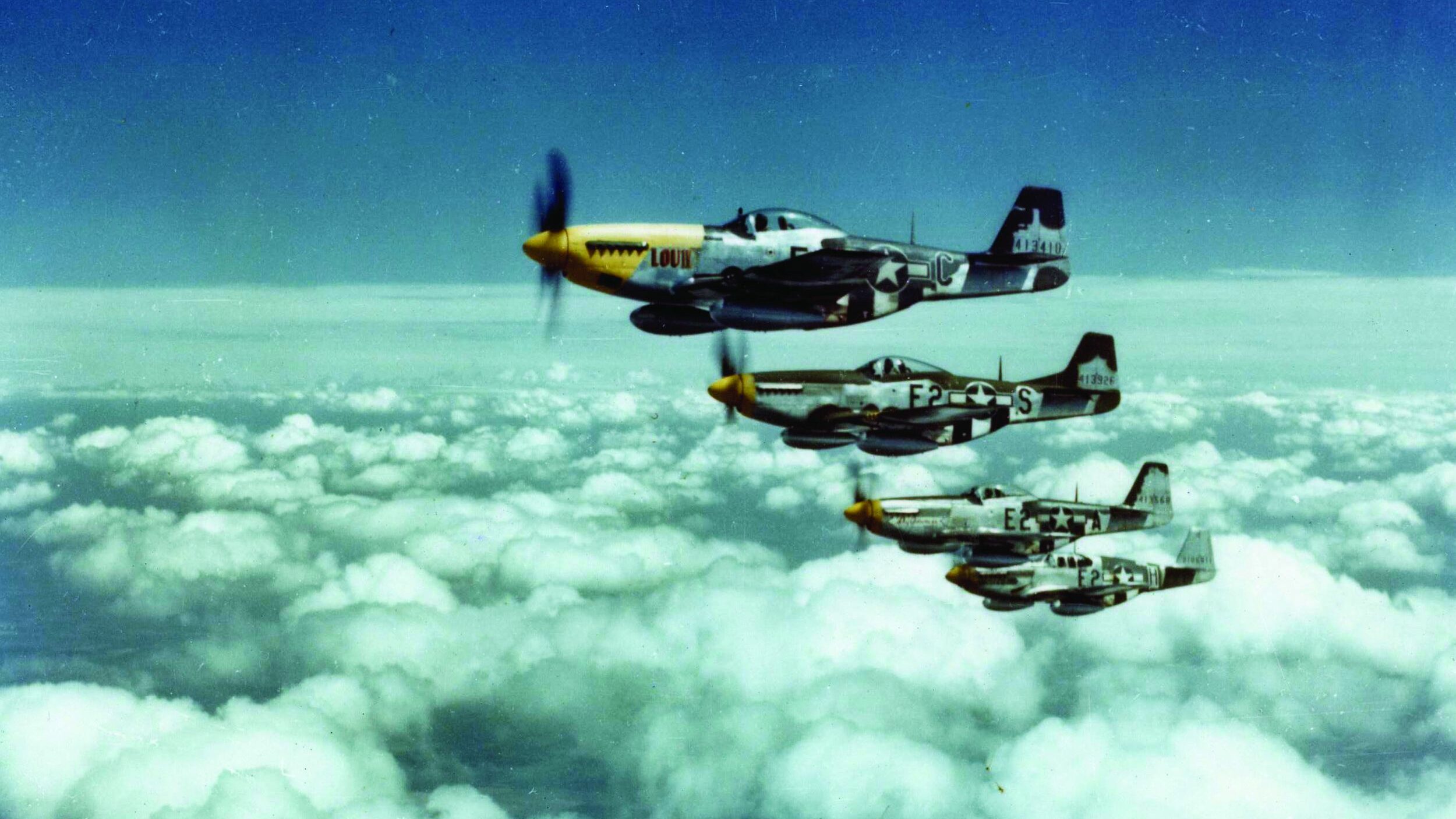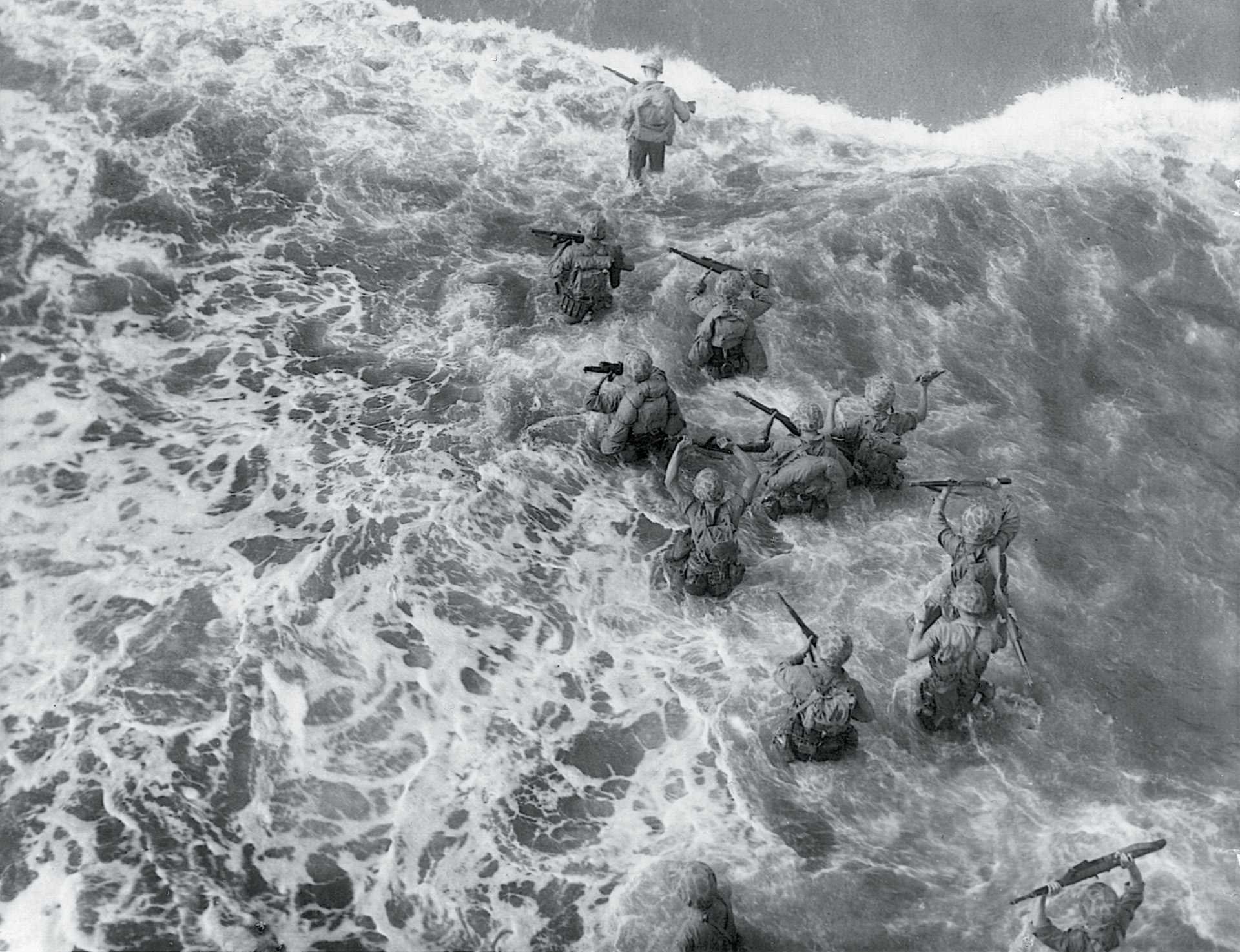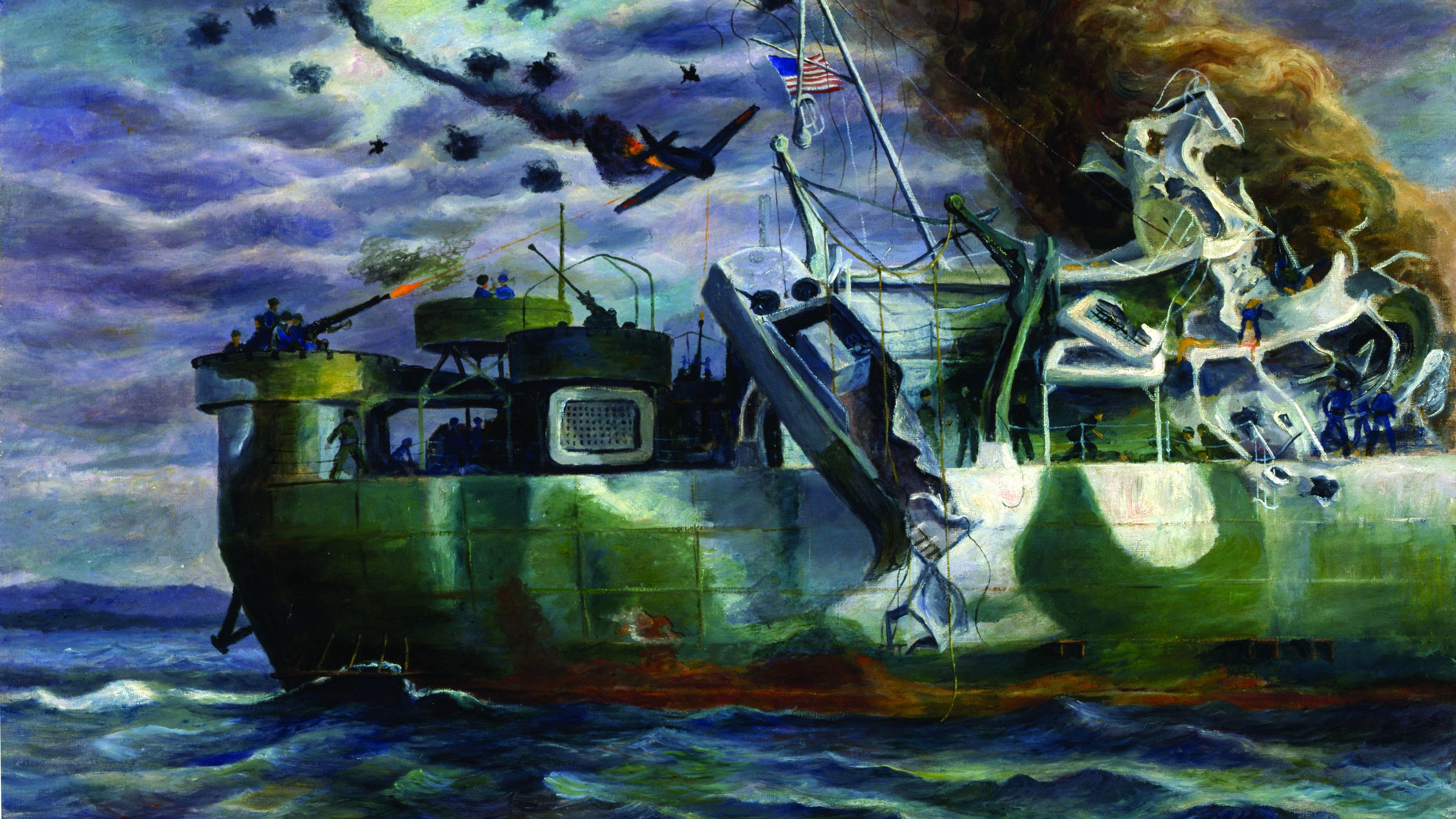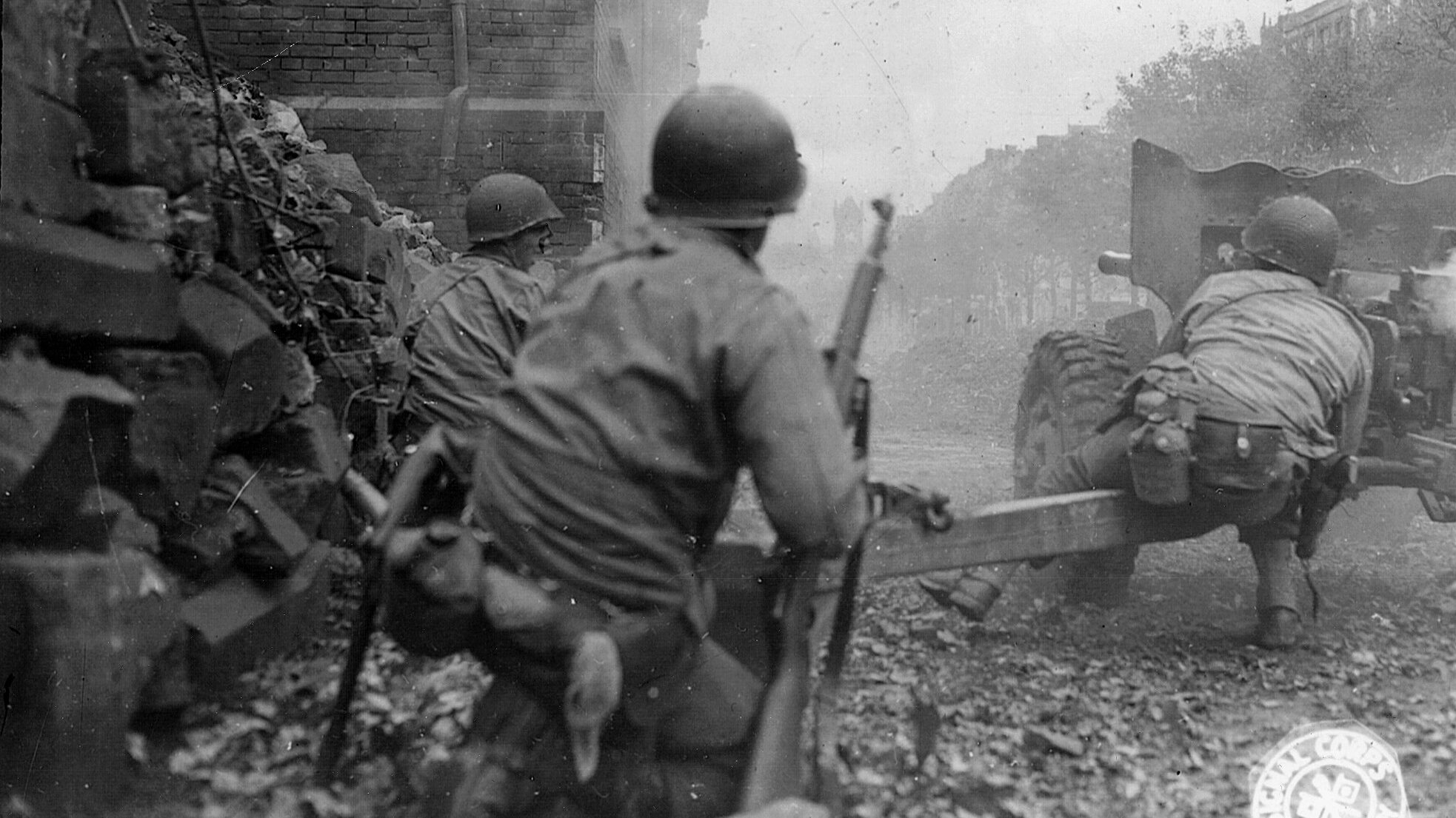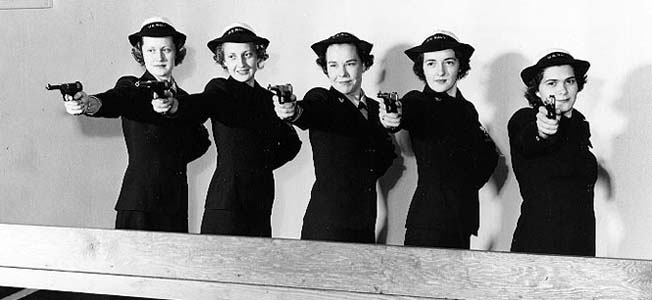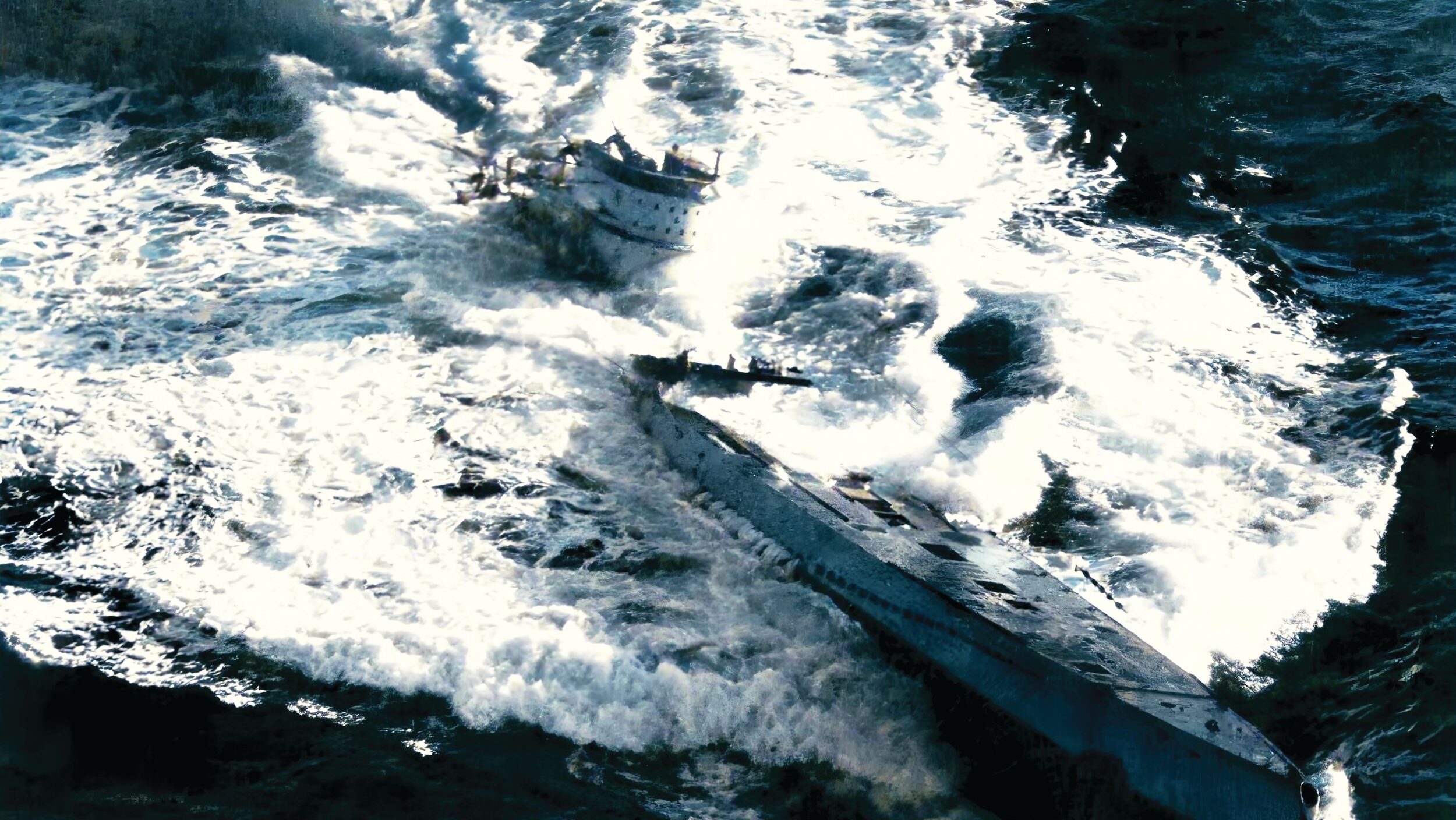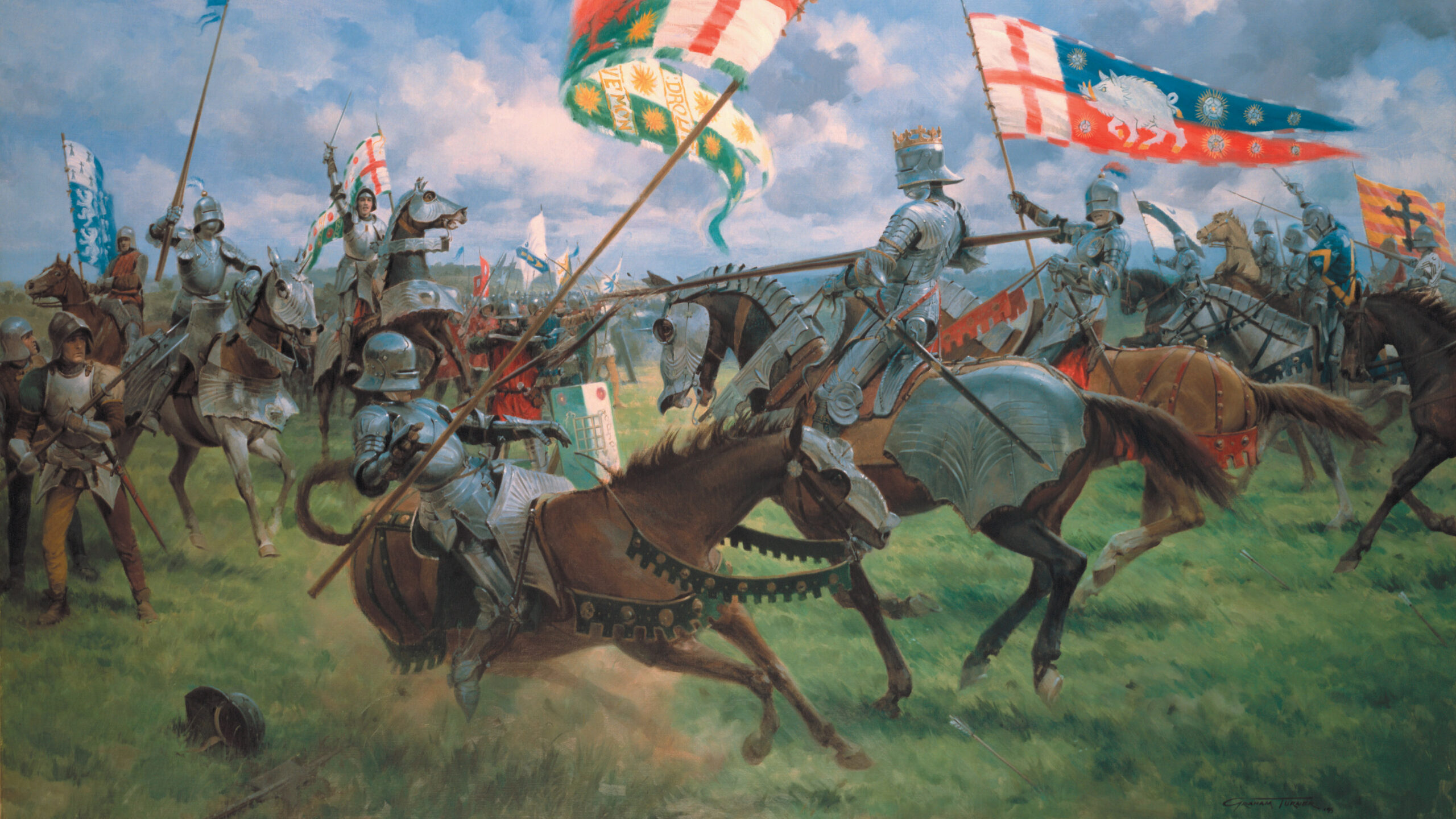By David H. Lippman
At 12:30 PM, June 19, 1944, two vast fleets hundreds of miles apart faced off amid cobalt skies and burning seas. On one side, a 30,000-ton aircraft carrier blazed in her death throes, while a second carrier crew battled an immense fire. On the other side, an immense fleet steamed almost unimpeded past the burning wrecks of 130 aircraft sent to sink them. The Battle of the Philippine Sea was almost halfway through its first day, vast destruction had taken place, and even more was yet to come.
All morning, Japan’s Vice Admiral Jisaburo Ozawa had hurled the first two of four major airstrikes from his nine carrier decks—the guts of his 1st Mobile Fleet—against 15 American carriers that comprised the strength of the US Fifth Fleet, under Vice Admiral Raymond A. Spruance. At stake was control of the Marianas Islands generally and the island of Saipan specifically, as the U.S. Marine Corps was storming the rugged volcanic island.
To the Americans, the assault on the Marianas was one more step on the road to Tokyo. To the Japanese, holding those same islands and defeating the U.S. Navy was the “Decisive Battle” dreamed of in pre-war naval planning. But those plans had called for a “fire-away Flanagan,” with pagoda-masted battleships flying the Rising Sun ensign slugging it out in battle line against cage-masted American dreadnoughts. While both vintage ships were still in business, the new queen of the seas was the aircraft carrier, and this “Decisive Battle” would be fought by two foremost experts in the subject: Ozawa and Spruance. Ozawa had learned his trade as a theorist and combat commander; Spruance a harder way, by being flung into command of the American carriers just before the Battle of Midway after a career of surface command, and then winning a decisive victory.
But the commanders had different objectives: leading a fleet short of fuel to begin with, Ozawa had to concentrate his ships in Borneo to access their oil wells. The good news was that the crude oil was of such high quality it could be poured straight into his ships’ bunkers without refining it. The bad news: it was still crude oil—it damaged those bunkers and could explode easily. And with his oil shortages, Ozawa could only make one massive thrust against the Americans, then retreat from the battle. He was operating on a short leash.
In comparison, Spruance was tethered to a different leash—the Marine Corps’ Saipan invasion force. He had plenty of fuel and ammunition to maneuver, but could not leave the amphibious ships, landing craft, and their support vessels exposed.
The morning of June 19 saw massive Japanese air strikes on the American fleet, none of which did serious damage. But American submarines spotted the Japanese main force, and USS Cavalla became the first American submarine to sink a Japanese fleet carrier, disemboweling Shokaku, one of the six that had attacked Pearl Harbor in 1941, while her sister Albacore torpedoed the brand-new fleet carrier Taiho, Ozawa’s flagship, creating a damage-control issue. The hit had ruptured oil bunkers, and poorly-trained damage control crews tried to repair ruptured fuel and oil lines or pump overboard fuel from damaged tanks. A lot of the unrefined Borneo crude sloshed around the carrier’s hangar deck. At this point, as American submarine historian Ed Beach would write caustically later, one of Taiho’s ill-trained damage control officers made a decision that “qualified (him) for the United States Navy Cross,” by starting all blowers and fans and opening all ventilation lines and bulkhead doors to reduce the concentration of fuel vapors and clear the atmosphere. This vastly increased the oxygen available to any source of ignition.
Meanwhile, the battle raged on. Ozawa had sent two raids against the Americans. The first had cost him 42 of 69 planes. The second consisted of 128 planes—97 fell to American fighter pilots and antiaircraft guns.
Ozawa launched his third raid between 10 and 10:15 AM, hurling 47 aircraft in the attack. It consisted of 15 Mitsubishi A6M5 Zero fighters, 15 Zeros armed with bombs, and seven Nakajima B6N1 Jill torpedo bombers. All came from his Group B, whose carriers were the Junyo, Hiyo, and Ryuho, commanded by Rear Admiral Takaji Joshima. They immediately got lost, failing to track the American movements.
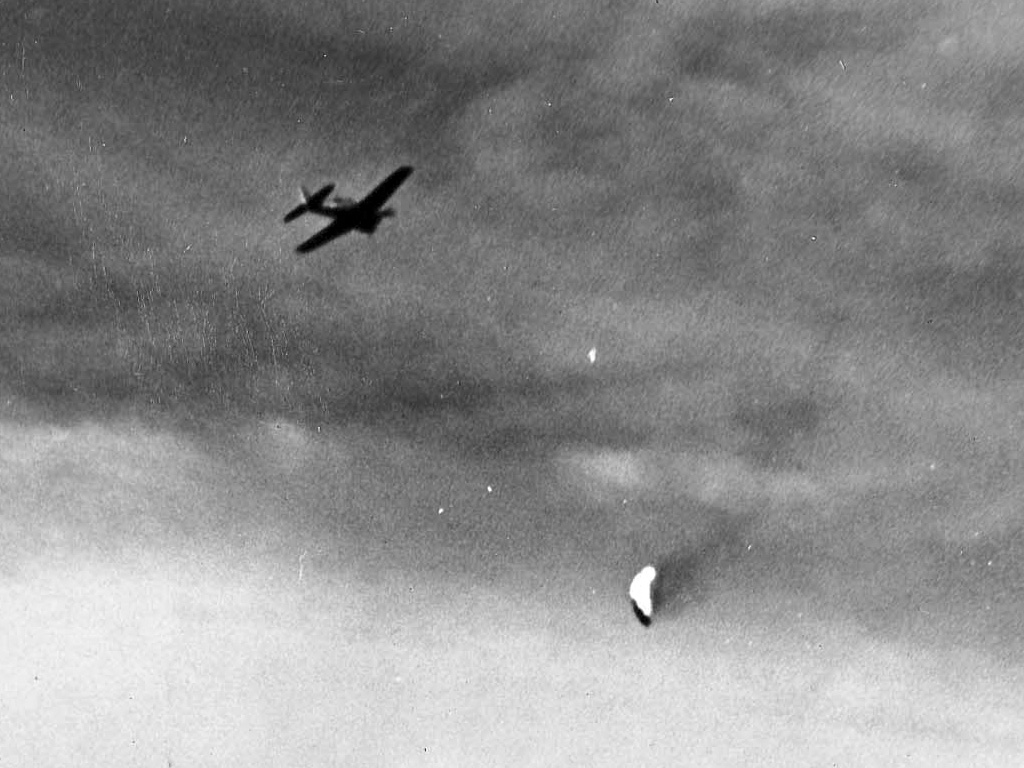
On USS Lexington, the flagship of the carrier task force, TF 58, Lieutenant Alex Vraciu, who had just shot down an incredible six planes in one engagement, posed for a grinning victory photograph that became iconic, and then found his port-wing stub’s red “barrel” was protruding, which meant that he had flown the best mission of his life with his port wing only partly secured. He had been lucky his wing hadn’t folded up in battle. He was lucky in his gunfire, too. He had fired just 360 rounds, averaging 10 rounds per gun per kill.
Up on the flag bridge, Vice Admiral Marc A. Mitscher, who commanded Task Force 58, the carrier arm of Spruance’s fleet, watched the planes flop down on his decks and saw the Japanese withdraw. A wrinkled man who cared for his sailors, he was only the 33rd naval aviator to earn his wings and gained a Navy Cross for a Trans-Atlantic flight in 1919 from Newfoundland to the Azores. He led with action, not rhetoric.
While he chafed against Spruance’s orders to stay on the defensive, Mitscher was determined to bring down every Japanese plane that neared his fleet, and the two keys to that were his outstanding fighter force of Grumman F6F Hellcats and the incredible antiaircraft power of Vice Admiral Willis A. “Ching Chong China” Lee’s battleships, operating directly in the path of incoming Japanese planes.
American radar picked out Joshima’s strike well north of TF 58 at 12:25 PM, 110 miles off. For the next hour, American sailors in Combat Information Centers watched the radar pulses and used markers to track the planes on glass panes. The Japanese course baffled Mitscher and his chief of staff, Rear Admiral Arleigh “31-Knot” Burke, as it didn’t make sense. Were the Japanese going to attack from the north? Was this yet another one of their decoys to draw off American strength while the main punch attacked in a different direction?
Mitscher decided to take action. He sent eight Hornets, four Hellcats, and 12 Langley F6Fs to attack—24 planes against 47. At 1:01 PM, the Hornets gave “Tally-ho” calls. Despite the numbers, eight Hellcats charged into 15 Japanese planes at 16,000 feet, and the Hornet’s Fighting 2 Squadron swept the sky with nine unanswered kills.
At 1:20, a handful of Joshima’s Zero bombers charged Essex, but only one reached an attack point. His bomb fell 600 yards wide. Two Langley planes put the valiant Zero pilot in a Hellcat sandwich, attacking from both sides, and Lt. (j.g.) Jerome D. Keyser gained the kill.
Raid 3 was almost a non-event—most of the Japanese planes gave up, and many returned to their carriers having done no damage.
On the American ships, Mitscher secured from general quarters, setting readiness “One-Easy,” which enabled everyone to get some chow, go to the head, and generally take a breather.
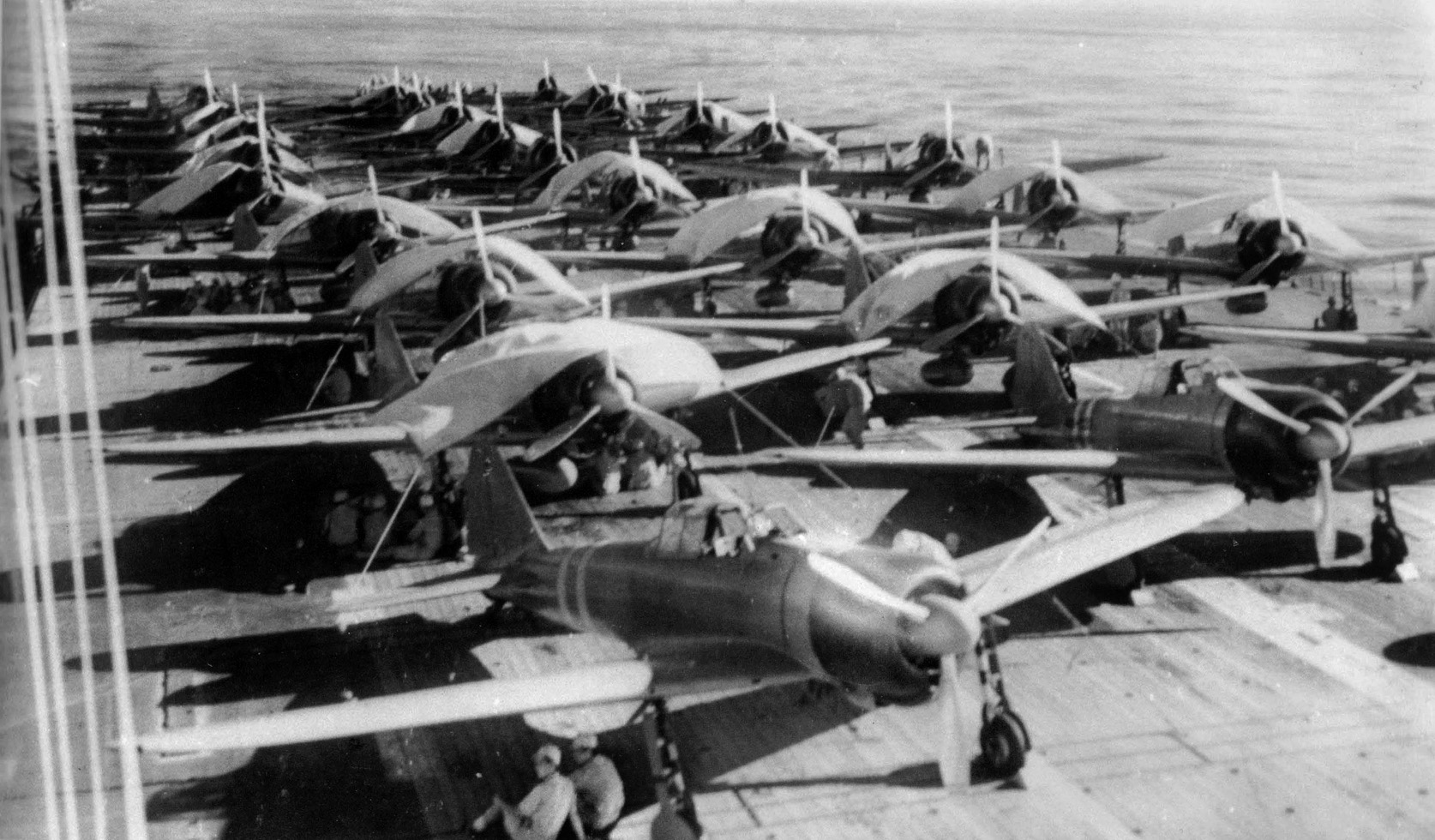
That breather ended with Raid 4, launched from Junyo, Ryuho, Hiyo, and Zuikaku at 11 AM, consisting of 84 planes: 27 Aichi D3A2 Val dive bombers, seven Yokusuka D4Y1 Judy torpedo bombers, 10 Zero bombers, 32 Zero fighters, and six Jills orphaned from Taiho, unable to launch aircraft because of her damage.
Ozawa’s carriers turned into the easterly wind. Steam spouted from vents in the flight decks forward so that carrier helmsmen could hold the wind straight down the flight decks. From catwalks, sailors waved their summer white hats in wide circles. Despite the loss of Shokaku and the damage to Taiho, the Japanese believed they were winning the battle from overstated damage reports by their pilots.
Lieutenant Zenji Abe, one of the few Pearl Harbor veterans, led his bomber division on his second mission of the day. Abe was increasingly nervous—not only was this his second attack, but he felt rusty from 40 days of flying a desk. As the formation droned along, there were the inevitable aborts as two element leaders couldn’t retract their landing gear, a Zero suffered engine trouble and headed back, and a dive-bomber and three Zeros simply disappeared.
When Abe’s band reached the expected intercept point 60 miles southwest of Guam, they found empty seas.
The orders were to attack the Americans, refuel on Guam, then return to the carriers. But with the vast American fleet present, every Japanese aviator knew that if they didn’t bomb an enemy target they would have to slam their planes into that target.
Abe and his pals were now running short on fuel. Eighteen of Zuikaku’s planes had to head home, while others flew to Guam and Rota. As it turns out, task Force 58 was north of Abe’s force.
Then the Japanese got lucky, with Ensign Nakajima broadcasting “Sir! Big enemy formation, left forward!” Abe wasted no time, ordering his planes to attack and personally leading six Judys and two Zeroes against TF 58.
Down below, the light carrier Monterey had picked the enemy up on radar at 1:20 PM. At first, the Americans weren’t certain if this was an attack or a returning American group. The planes did not come straight in, and IFF (identification friend or foe) was not reliable. That finally gave Japanese Air Group 652’s team of 16 Judys and Zeros time to attack an American carrier group.
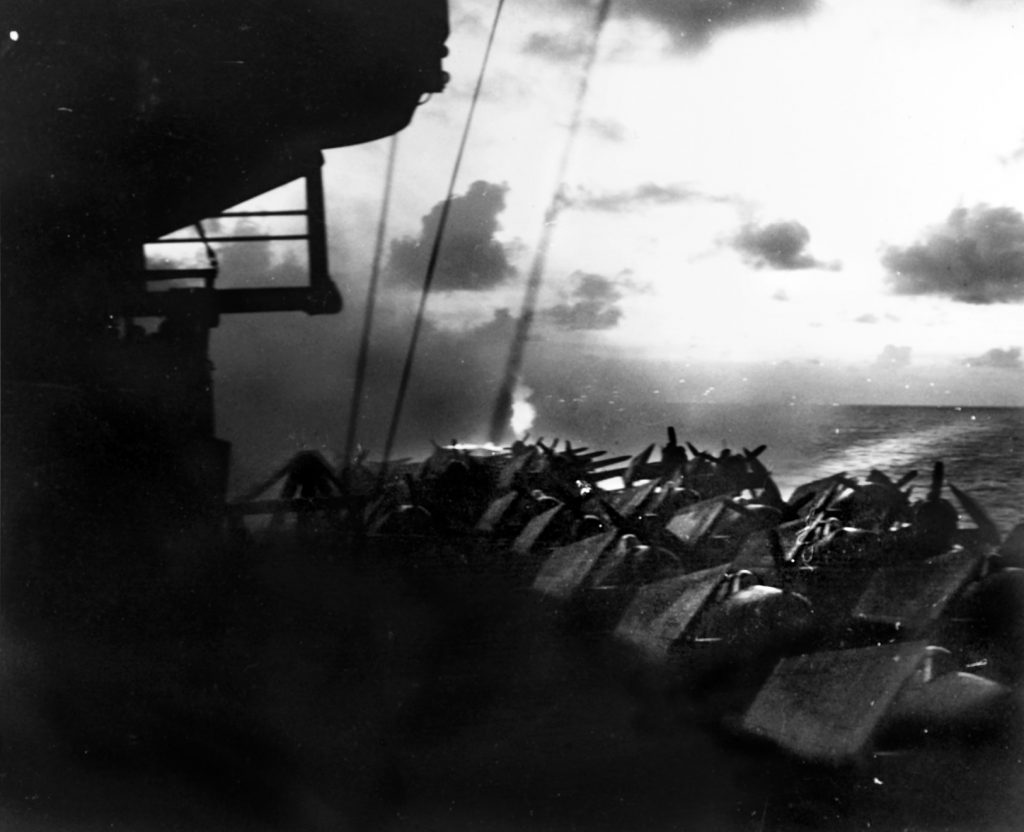
The Americans scrambled. Sailors rushed back to battle stations. Monterey tried and failed to contact her own fighter group. Fortunately, Monterey was able to pass the warning to the carrier Wasp, but her Fighter Direction Officer had the same problem, figuring out if the incoming planes were “bandits” or friendly. So the best thing to do was launch fighters. Two groups from the light carrier Cabot raced into the sky to join the Wasp fighters already on combat air patrol. At 2:13 the “bogeys” were confirmed as “bandits.” Wasp’s group started yelling “Tally-Ho!” at 2:20.
The fighters shot down two Zeroes and a Jill, but the remaining planes nosed over to attack the American fleet. Abe himself charged a fleet carrier—probably the Bunker Hill—against massive flak. “That was dreadful for me,” he said later. The barrage and explosions didn’t take down many planes, but wrecked their aim—even Abe’s. He dropped his bomb amid erupting five-inch shells loaded with proximity fuses and raced off, his bomb missing the carrier.
Abe wasn’t the only pilot who had a bad attack. Bunker Hill’s lookouts recorded three bombs exploding 50 to 200 yards off her hull. A Judy that attacked Bunker Hill survived flak but crashed near the destroyers. Cabot gunners shot off another Judy’s tail. A third Judy aimed its bomb at Wasp and followed it into the ocean.
The Japanese seemed to have it in for Wasp. One near-miss hurled a cascade of water on a catwalk, drenching crewmen. Two more blew up 80 yards off the starboard quarter, and a phosphorous bomb detonated 300 feet overhead, scattering white streamers but only injuring one sailor.
Overhead, Hellcats stormed into the attackers. Four pounced on Zenji Abe, who throttled his engine, studying his fuel gauge. He could not make it home or to Guam, so he headed for Japanese-held Rota Island, where he landed. When he hopped out of his aircraft, he studied all the bullet holes in its tail and said, “I never saw so many Grummans!”
Of the 18 attackers that hit the Americans in Raid 4, only half survived.
Overlooked by many in the wild battle had been the role of Lt. (j.g.) Charles A. Sims, in Lexington’s Combat Information Center, who had been listening to the Japanese attack coordinator’s radio transmissions and translating them into English for Mitscher’s benefit. Mitscher had ordered that one plane be left alone during the battle to gain advantages from knowing his orders. Now as Japan’s “Coordinator Joe” signed off and started for home, an officer asked Mitscher, “Should we get him now!?”
“No, indeed,” responded Mitscher. “He did us too much good!”

The 49 Japanese planes that headed for Guam neared the island and jettisoned their bombloads in case they crashed, and then faced a worse fate; 27 F6Fs from Cowpens, Hornet, and Essex, with Commander David McCampbell, the Navy’s ace of aces, leading the latter group. They plowed into the Japanese, breaking into the landing circle of a string of Val dive-bombers and chopping them up as they awaited their turn. Nineteen Japanese planes managed to survive the hail of bullets, only to be so badly damaged they could not be repaired. McCampbell picked up two more kills.
As the remaining Japanese planes shuffled into formation and headed back to Zuikaku, more bad news befell Ozawa, this time beneath his feet. At 3:32 PM, the Taiho’s damage control officer’s earlier order to run the ship’s fans and open her ventilation systems to dissipate the Borneo oil fumes finally impacted in dramatic form.
The vapors of the unstable and unrefined fuel set off a massive internal explosion that sent the armored flight deck bulging upward from the blast. Below the waterline, the explosion shot gigantic holes in Taiho’s hull, dooming the blazing carrier. She began settling on an even keel. Most of her crew was killed in this explosion. Ozawa, on his flag bridge, was devastated and said he would go down with his doomed flagship. His staff officers talked him out of it.
Two destroyers approached the blazing carrier, and Ozawa, his staff, and the Emperor’s portrait were taken by lifeboat to the destroyer Wakatsuki. From there, Ozawa transferred to the heavy cruiser Haguro to resume command. But there was yet another problem—the cruiser’s radio room was not configured to handle the communications needs of the entire task force, and the only set of codes Ozawa had for sending messages to Tokyo was going to the bottom of the Pacific on Taiho. It would take hours to get a message through to Combined Fleet Headquarters, which could be disastrous in a battle that was turning into an even bigger disaster.
Taiho was now a fiery hulk, suffering from more explosions. At 6:28 PM, Japan’s newest aircraft carrier, sailing on her first combat mission, endured one more blast and then rolled over to port, taking 1,650 out of her 2,150-man crew to the bottom of the Pacific.
So far, Japan had lost two fleet aircraft carriers, while the Americans had suffered minor damage on two carriers, two battleships, a heavy cruiser, and a destroyer that had taken some antiaircraft hits from friendly fire. The damage was anything but serious to the American fleet, except for 30 sailors killed.
More importantly, the Americans had lost a bare 31 aircraft, while Ozawa had suffered a staggering loss of 314 planes. With those losses came the end of Japanese naval aviation.
One survivor, however, sat in Rota, pondering his luck of survival. Veteran Zenji Abe wrote his thoughts later: “I was snatched from the jaws of death.”
On the American ships, as the sun set and the constellation Scorpio with its blood-red leading star Antares rose over the ocean, Mitscher released his men from general quarters and set torpedo defense watch. Carrier aviators were offered their two bottles of after-action beer, but fifths of Old Overholt and Jack Daniel’s mysteriously appeared in squadron ready rooms. Fighter pilots described their dogfights to each other, pausing occasionally to drink toasts to the 14 fighter pilots and 13 other aviators missing or known dead.
On Wasp, the sole casualty was Gunner’s Mate Alfred E. Bridges, a 23-year-old New Yorker. His shipmates collected $2,352 for his wife and six-month-old son, to tide them over until the $10,000 GI life insurance kicked in. June Bridges wrote back, thanking the shipmates for the money, saying that it would enable Alfred Jr. to set up a college fund.
Among the celebrants was Lt. (j.g.) Zeigel Neff, on Lexington, who claimed four kills—his only score of the war, which meant he missed “ace” status by only one kill. However, his summation of the day’s fighting was passed up to the flag bridge: “It was just like an old-time turkey shoot.”
Mitscher, Spruance, all of America, and future naval historians would forever remember his quote as “The Great Marianas Turkey Shoot,” but the admirals still had a battle to fight. The Japanese, minus two carriers, were still out there, but the Americans did not know where.
Now Spruance had the Fifth Fleet head west, with the battleships leading, to locate the Japanese. The big constraint was fuel. If the Americans advanced too far west, they would run out of range of their oilers and tankers. If they paused to fuel, the Japanese might slip away. Mitscher and his staff discussed the situation, and 23 knots west was the best compromise. With that decision taken, Mitscher rose from his admiral’s chair, yawned, stretched, and said, “Tomorrow I’m going to get a haircut.”
Meanwhile, Ozawa faced total disaster, as well as new orders from Admiral Soemu Toyoda, who commanded the entire Japanese Navy. Toyoda did not have a good picture of the battle because of the communications breakdown, and he exhorted Ozawa to continue “mopping-up operations around Saipan,” believing earlier reports that the 1st Mobile Fleet had annihilated the Americans. Just before midnight, Ozawa headed northwest, the Americans 320 miles behind him.
In the dark, the advancing TF 58 ships saw a flashing light in the darkness, three short, three long, three short: an SOS call. The destroyer Boyd sprinted over and pulled Lt. (j.g.) William C.B. Birkholm, who had spent 14 hours in his life raft, to safety. He was delighted to be pulled out of the drink and sat in the wardroom, drinking coffee.
Dawn rose on weather that still favored the Japanese—winds from the east, which would force Mitscher to turn east to launch his strikes. At dawn, Enterprise entered the fight when she launched four search teams. For five hours, they searched for the enemy but found only Ozawa’s own search planes, which were both unsuccessful in finding the Americans or surviving their searches.
Just before noon, Ozawa’s ships rendezvoused to refuel from their tankers, and he shifted his flag again to Zuikaku, whose radio and coding facilities could handle his communications. The surrounding carriers were able to report their appalling losses to him at last, but based on optimistic reports from his shore-based air units, Ozawa continued the battle.
But at 1:40 PM, Commander William R. “Killer” Kane’s search planes from Enterprise finally located their quarry. Lt. (j.g.) Edward Laster spotted something American airmen had not seen in 20 months—Japanese carriers at sea. He radioed in the clear: “Enemy fleet sighted.” Lt. Robert “Railroad” Jones headed back with the precise position, while Lt. Robert S. Nelson studied a Japanese carrier “leaving a circular wake as it turned after we had been in view for four or five minutes.” He reported the enemy fleet’s location. The Japanese picked up the message and translated the communication for Ozawa.
On Lexington’s flag bridge, Mitscher studied the report and realized they were 250 miles from the enemy. Mitscher ordered at 4 PM, “Expect to launch everything we have. We will probably have to recover at night.” Doing so was a gamble—it was hard enough to land a plane on a carrier by day, but doing so by night was a stretch, particularly for planes short on fuel.
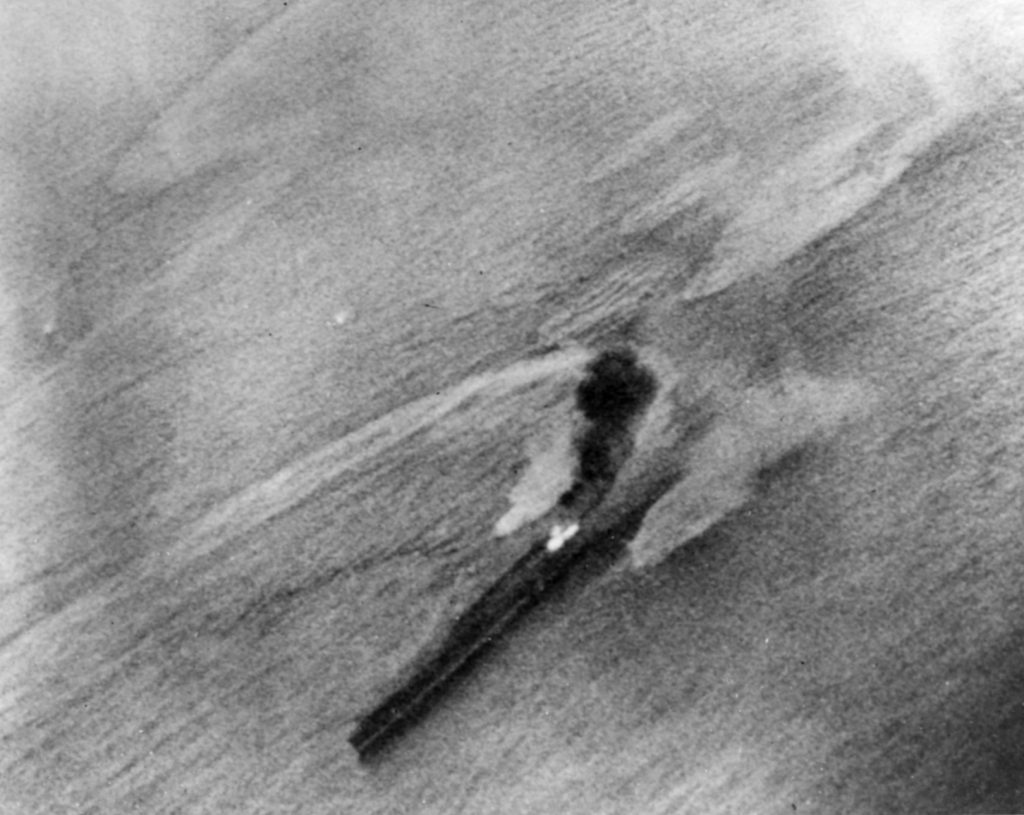
Nevermind; everybody was ready to go. For the first time, the Navy would hurl its SB2C Helldiver dive bombers into an attack—great things were expected from this replacement for the reliable SBD Dauntless. In the ready rooms, pilots, radiomen, and air-gunners hunched over their navigation tables and wrote down critical information. After that came pep talks from the bosses. On Enterprise, Commander James D. “Jig-Dog” Ramage, commander of Bombing 10, told his aviators: “We’re going to be gas misers.” Behind him, an officer wrote in six-inch black letters: “Get the carriers!” It was a sentiment shared in Monterey’s VT-28 ready room, and by a banner on Belleau Wood. Mitscher himself told Lexington airmen: “Give ‘em hell, boys. Wish I were with you.”
While the airmen were briefed, crewmen prepared a deckload strike of 240 planes from 11 carriers. TF 58 turned into the wind, ships cracking on full speed. In the engine rooms, temperatures soared to an almost unbearable 130 degrees. At 4:24, the first planes rolled down the flight decks.
With a few aborts, 226 aircraft headed for the Japanese, 95 F6F fighters, 54 TBF and TBM Avengers, and 77 dive bombers, including 26 SBDs from Enterprise and Lexington. It was one of the heaviest airstrikes the US Navy had ever hurled.
Led by Lieutenant Red Carmody of Bunker Hill’s VB-8, aviators from 25 of the 48 United States, aged 19 to 45, headed west, many clutching lucky charms which ranged from St. Christopher medals to one pilot who carried a pipe, ivory die, screwdriver, and two nuts and bolts.
The planes headed on course 290 true at 12,000 feet. Planes rendezvoused over the carrier decks quickly to group by role, fighters over the bombers, Alex Vraciu and his division doing lazy S-turns to avoid outrunning Lexington’s SBDs.
Ramage nursed his elderly Enterprise SBDs along, and at 260 miles spotted three dozen planes veering to port. Then he saw the Japanese fueling group and realized it was their top cover. Some of his planes dived on them. He broke radio silence on the VHF “guard” channel and addressed all his buddies: “We will not attack. The Charlie Victor (aircraft carriers) are dead ahead. What are you trying to do? Sink their Merchant Marine?”
Didn’t matter. Wasp’s Helldivers were low on fuel, and their leader, Lt. Cdr. Jack Blitch, wanted to get a kill somehow. Three Helldivers swooped down on each of the four oilers and four Avengers on a fifth. The attacks were spectacular: one oiler appeared to “explode and disintegrate” from its unstable Borneo crude. Another was set afire to sink, and a third left dead in the water as the fourth shuffled off, leaking oil. The sunken ships were Seiyo Maru and Genyo Maru.
Ozawa’s combat air patrol of six Zeroes swooped in on Wasp’s planes, shooting one down, and the Wasp group, having done its duty, headed home.
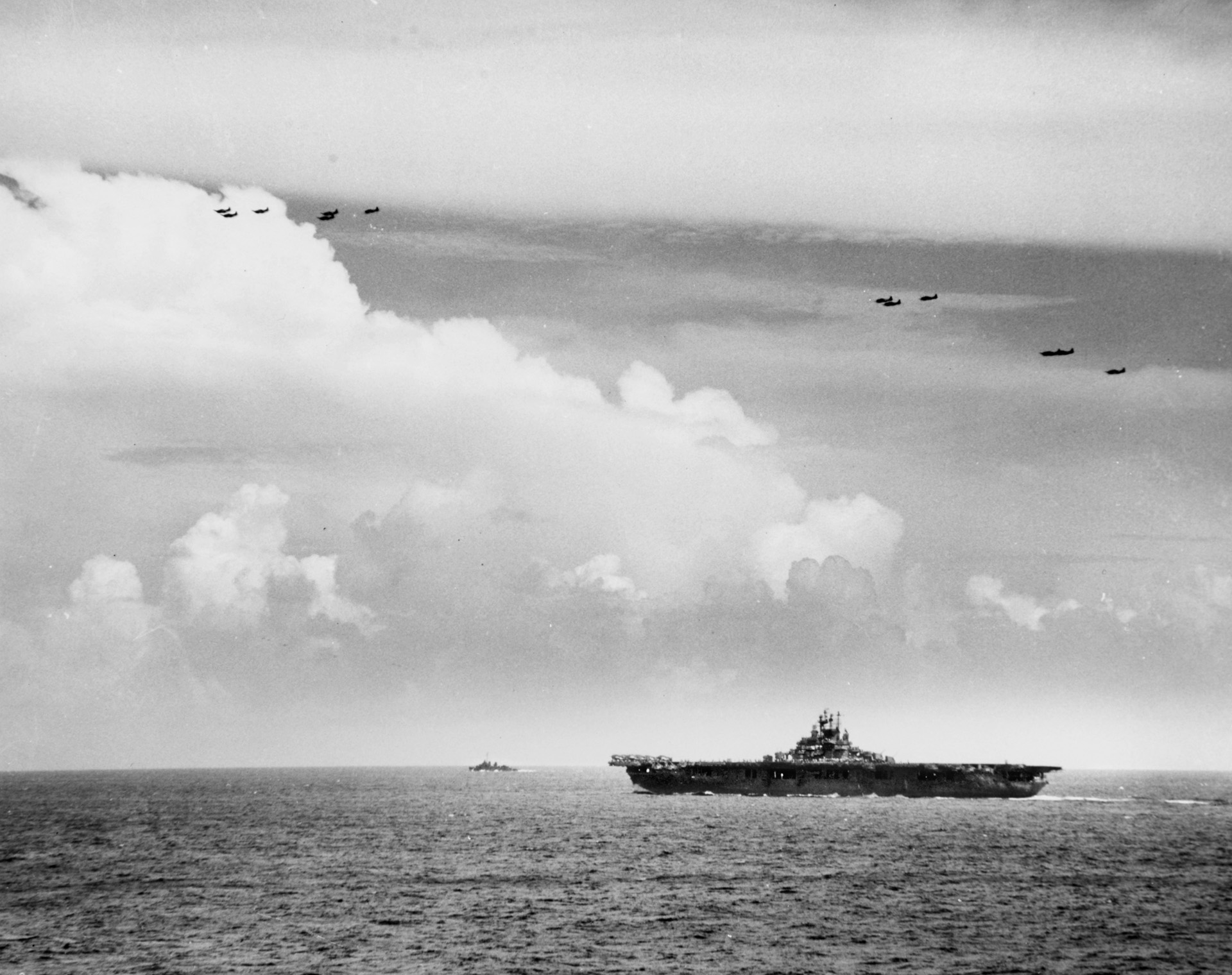
Now the rest of the strike found Ozawa’s main force 35 miles west of his slow-moving oilers, under five-tenths cloud cover between 3,000 and 10,000 feet. Many of the American pilots were witnessing a tableau they had never seen before: Japanese warships, from carriers and battleships down to destroyers, maneuvering beneath them to evade attack. Aviators started yelling spontaneous reactions, and Ramage told his men that the outbursts were “completely unwarranted transmissions.”
Down below, Ozawa was preparing. Shipboard buglers blared the call to action stations, and he was able to launch 40 Zero fighters and 28 Zero fighter-bombers. Sixty-eight fighters were not enough to defend his forces, which were still scattered across the Central Pacific, and many of the aviators were nearly untrained. But it was all he had.
At 6:03, Japanese radar plotted the incoming Americans, and Japan’s Air Group 653 headed for them, spotting the Americans nine minutes later. Seven US air groups charged down into the Japanese fighters, into a wild melee that left 20 American F6Fs and eight of the highly-touted Helldivers shot down. The latter proved exceptionally vulnerable. Seven more F6Fs, four Avengers, and a Dauntless, fleeing the scene with battle damage, were write-offs when they were recovered.
The first set of attackers, from Hornet, Yorktown, and Bataan, stormed down on Zuikaku. The aviators from the first two carriers had a score to settle. Zuikaku’s aircraft had sent the original American carriers that bore those names to the bottom in 1942.
Dive bombers and fighters raked over Zuikaku, treating the carrier to a solid dose of armor-piercing weaponry and .50-caliber bullets, ripping holes in the flight deck and cutting down crewmen, even wounding one of Ozawa’s staff officers. Up above, eight Zuikaku Zeroes saw that they could no longer land on their ship and had to splash in the water. Few pilots were recovered, further whittling down Ozawa’s aviation strength.
The Americans pulled out, believing that “a large hole, rimmed with fire apparently emanating from the flight deck” would send Zuikaku to the bottom. Zuikaku was heavily hit and suffered the concussion effects of several near-misses, but the carrier, which had already survived three major Pacific battles, was lucky again.
Meanwhile, planes from Lexington, Enterprise, San Jacinto, and Belleau Wood attacked Hiyo, Junyo, and Ryuho. The first two were converted ocean liners, which meant that they lacked armor. Lt. Charles W. Nelson of Yorktown led the strike and launched his torpedo against Ryuho. He kept on, exposing his plane to Japanese gunners, which cut him down. Ryuho evaded all five torpedoes from the Yorktown pilots.
In the slanting sun, the attacking Americans had a perfect view of Hiyo and her pals—which included a battleship, a cruiser, and eight destroyers. Ralph Weymouth, an old-timer at age 27, led the SBDs at 12,000 feet. He owed his veterancy to having flown off Saratoga during Guadalcanal. Studying the enemy, he chose Hiyo as his target and charged down, Alex Vraciu’s fighters accompanying him. The Japanese combat air patrol took advantage of cloud cover to pounce on the Americans, and Vraciu had no idea of the gravity of the situation until he saw Lt. (j.g.) Warren E. McClellan’s crew bail out of their burning TBF.
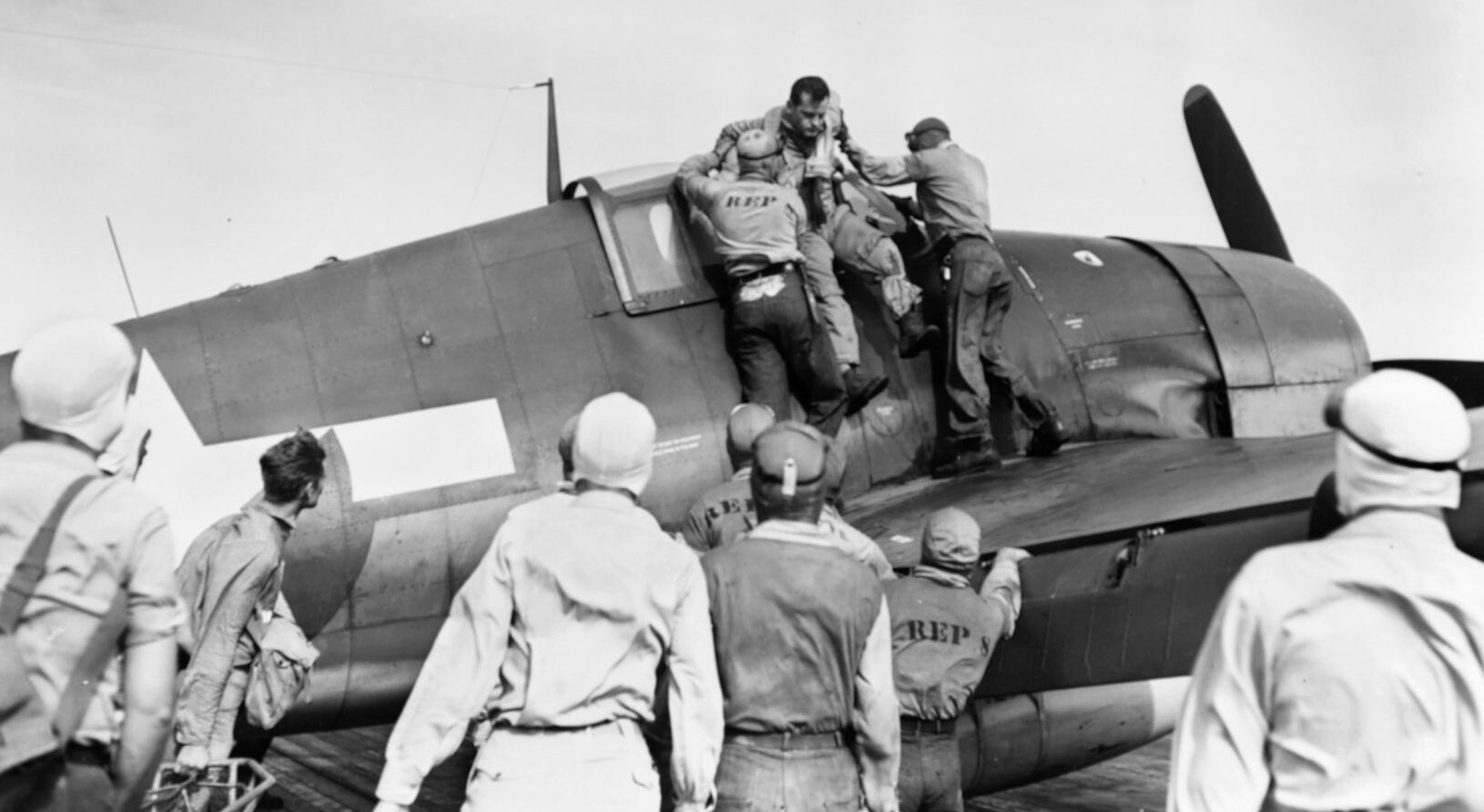
Three Hellcats in Vraciu’s group took on eight Zeroes. Vraciu and his wingman, Ensign Homer W. Brockmeyer, attacked. Vraciu scored another kill, but Brockmeyer went down, streaming smoke. Vraciu chased after his wingman to at least see where he would bail out, but two Zeros intervened and Vraciu had to save himself.
The Americans had suffered enough indignities at the hands of Ozawa’s combat air patrol and shot back hard. Torpedo 16’s Aviation Motor Machinist’s Mate 1st Class Jack W. Webb shot down a Zero that got too close, sending it spiraling into the water and earning a Distinguished Flying Cross.
Weymouth’ SBDs, lower, slower, and older than the Avengers, drew most of the Zero gunfire. His gunner, Aviation Radioman 1st Class William A. McElhiney, saw “bogeys” approaching astern. He pushed his mid-canopy section forward, folded the rear section down, slammed down on the gun bay pedal to open it, and had his .30-caliber guns ready. Soon everybody was ready, too, and firing on the Zeros approaching from the stern.
Bunker Hill’s “Minutemen” dived on Hiyo at 7:04 PM, hurling 500- and 1,000-pound armor-piercing and high explosive bombs on their target. Weymouth remembered narrowly missing a similar Japanese carrier at the battle of the Eastern Solomons in 1942. Now he had a perfect setup—down-sun, upwind, along Hiyo’s axis, right in his sights. His older SBD Dauntless, with its inherent stability and light control, was proving superior to the new and supposedly better SB2C Helldiver.
Weymouth wasted no time. He pressed the red button on his stick at 1,500 feet, moved the flap selector lever rearward, pulled in his dive brakes, hauled back on the stick, pulled out, and gunner McIlhenney reported a hit right beside the carrier’s island. The blast killed most of the senior officers and bridge crew.
With smoke pouring out of Hiyo, she seemed doomed, so other planes attacked her sister, Junyo, with Lieutenant Cook Cleveland claiming a hit on her stern. The dive bomber pilots scored one hit on Hiyo and two on Junyo.
Next came Jig-Dog Ramage and his Enterprise pilots, the dive bombers attacking Ryuho and Junyo, Hellcats charging ahead of them to suppress Japanese flak. Ramage followed the training he had been given by Midway hero and fellow Enterprise aviator Dick Best to make a near-vertical attack, right through exploding flak shells. At point-blank range, he released his bomb. It fell close astern of Ryuho’s wake. Sandwiched by Zeros overhead and flak below, it was a tough attack for Enterprise’s VB-10. At least Ramage had the satisfaction of seeing a Zero pilot make a halfhearted pass at his plane and flee. “No guts,” Ramage thought.
Enterprise was not finished with Ozawa’s carriers yet. Now came VT-10 Avenger torpedo bombers. Having overcome the technical problems of their early-war fish and been provided with the new Avenger, the “Torpeckers” were among the toughest attackers in the fleet. They would tell their rivals at the Royal Hawaiian Bar: “If you want to let air into an enemy ship, drop a bomb on him. If you want to let in water, torpedo him.” That, of course, would often lead to pitched brawls.
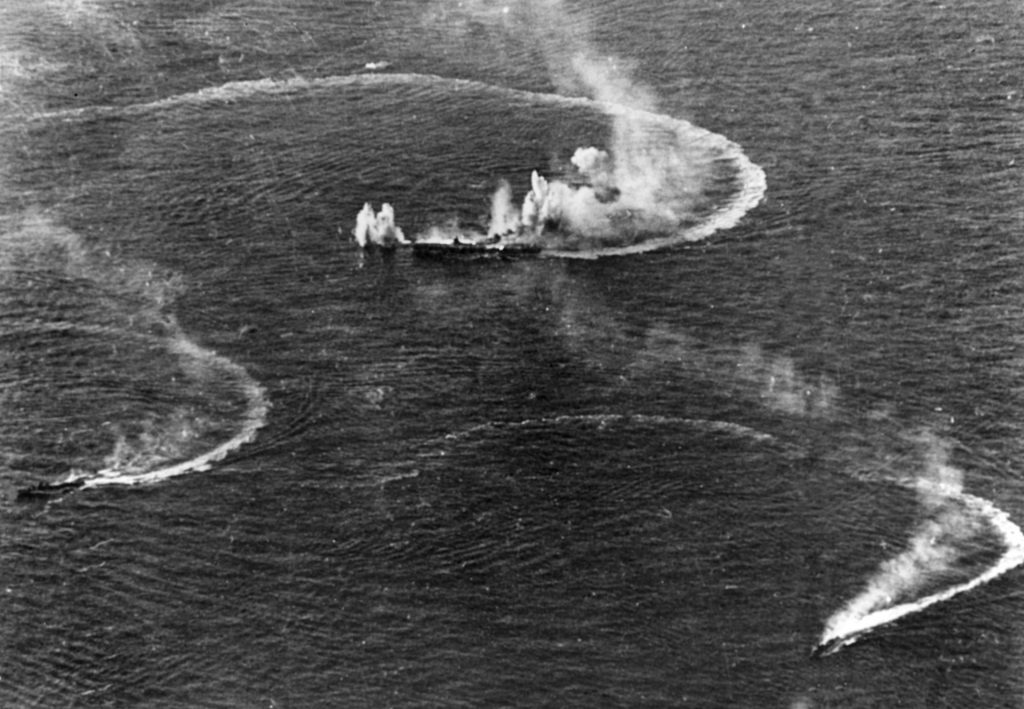
Now Enterprise and Lexington torpedo bombers attacked all three carriers and the battleship Nagato, which hit back with her massive 16-inch guns, which did no damage. Nagato didn’t take any, either, despite a lot of attention. The main American targets were the carriers.
Lieutenant George Brown ordered his division to execute an “anvil” attack on Hiyo, with his planes coming from her starboard, port, and bow. Hiyo would have no way to escape. He was right. On Hiyo’s bridge, Captain Toshiyuki Yokoi could only look on, unable to thread his 24,000-ton carrier through the knives of torpedoes headed at his ship. At least one tore open Hiyo’s starboard quarter.
The last American attack of the day saw Bunker Hill, Cabot, and Monterey’s planes try to hammer the light carriers Chitose, Chiyoda, and Zuiho. Lookouts on the cruiser Maya reported 50 incoming Avengers, but there were actually 16. As the Americans attacked, seven Japanese planes trying to land on their carriers were shot up by “friendly fire” from panic-stricken Japanese gunners.
The Americans hurled torpedoes and bombs at Chiyoda, which escaped with some good maneuvering, and the 30-year-old battleship Haruna, which avoided being sunk despite three 500-pound bombs that struck the aft turret and quarterdeck, killing 15 men and threatening a magazine. But her skipper, Captain Shigenaga Katazuke, flooded the area, and the 31,000-ton battlewagon kept formation at a snappy 27 knots.
Four carriers had suffered damage, but Hiyo’s condition was the most serious. Soon, leaking gasoline vapor set off an explosion, and Hiyo shuddered. Destroyers were able to rescue 1,000 of her 1,250-man crew as the 20,000-ton carrier sank.
The loss of three carriers in two days shook Ozawa to his core. More bad news was flooding in. Zuikaku had suffered a serious bomb hit aft of the bridge, Junyo two hits that “crushed” her stack and made her flight deck useless, Chiyoda a hit on the flight deck aft, and there was damage to Ryuho, Haruna, and Maya. In addition, the dogfights over his ships had cost him anywhere from 19 to 26 fighters.
Ozawa toyed with turning his battleships, cruisers, and destroyers around and engaging the enemy in a surface action in the night, traditionally Japan’s trump card, but he was all too aware that he had only 35 carrier planes left operational. If Ozawa tried a night battleship attack, once the sun rose over the Philippine Sea his entire fleet would be open to a combined air and surface onslaught. The only choice now was to withdraw in defeat.
The Americans, however, had no choice in this situation. They had one mission now, to recover their returning aircraft in the increasing dark.
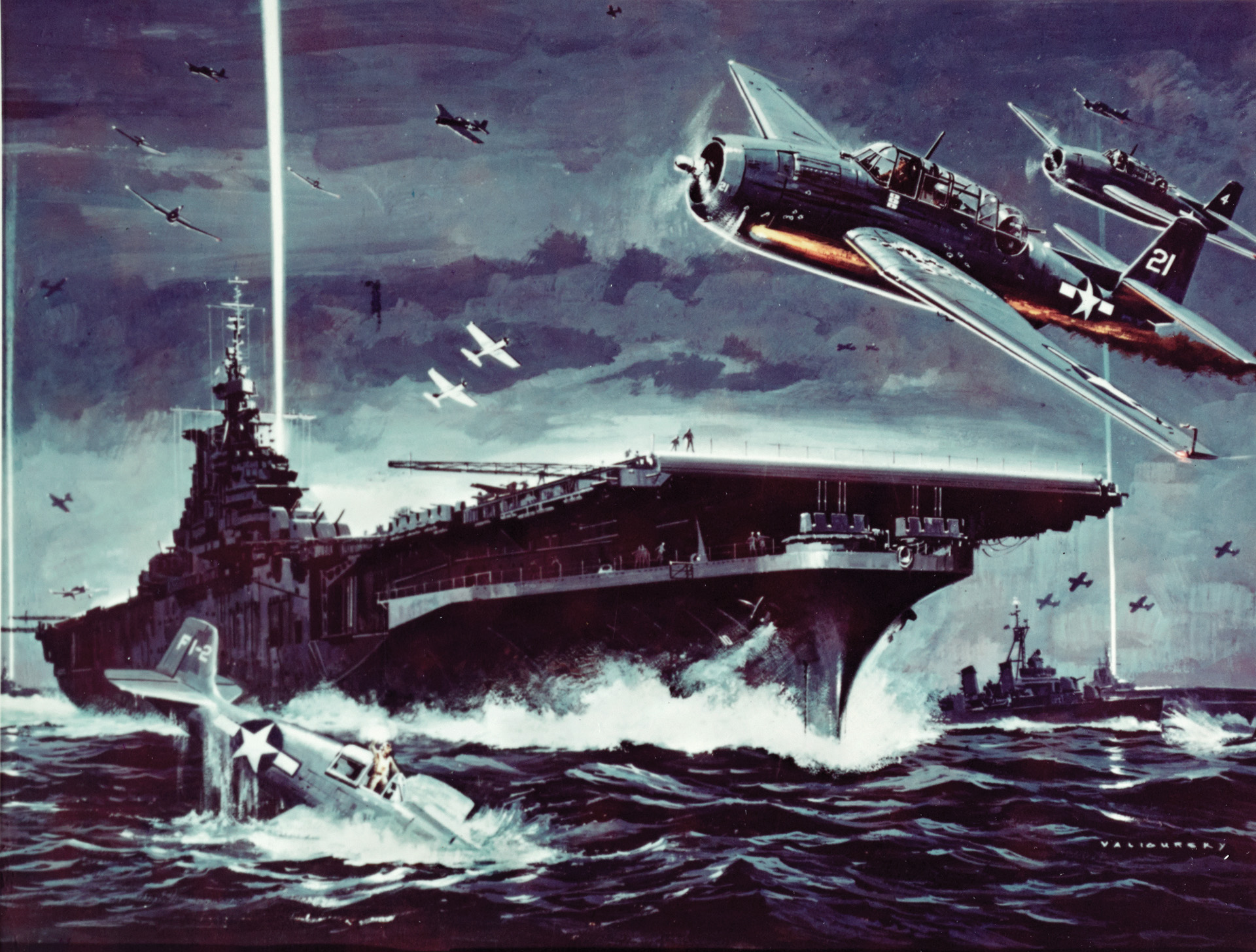
The combat portion of the Battle of the Philippine Sea was over, but now would come the most difficult portion of the battle for Task Force 58 and its weary sailors, from Mitscher on down to oilers and cooks. Many of these men could barely stay awake, but as the sun set they had to go back to work to recover the strike, doing everything from manning landing signal stations on flight decks aft to preparing dinner meals for famished fliers.
The returning aviators were exhausted, too. They struggled to regroup into their divisions and squadrons in the dark. Sunset was at 7 PM on the dot. It was the first night of a new moon, and visibility was near zero. So was gas in many of the planes. Normally well-disciplined aviators broke radio silence, spouting concerns over disorientation and fuel shortages. Some called for pals. Others even broke into tears from the fear of their damaged planes going down into the ocean. Pilots who had heard enough switched off their radios.
On Lexington’s flag bridge, Mitscher and his staff worried about the issue of recovery after dark. TF 58 had moved 90 miles west, which could save a lot of pilots, but likely not enough. In the dark, many planes would have trouble making landings—many more would likely splash into the sea. The only way to make TF 58’s location known to the aviators was to illuminate the entire task force. But doing so would reveal the ships to Japanese submarines lurking in the area.
The procedure was simple—show running lights, masthead truck lights, deck-edge glow-lights on the carriers. Other ships would illuminate the sky with searchlights, turn on signal lights, and even fire off star shells. The hard part was making the decision.
Mitscher made it. “Turn on the lights!” was the apocryphal order, but it had the desired impact. Powerful lights flashed on from TF 58’s ships, which made the fleet visible. Suddenly, the aviators knew where TF 58 was. The problem was that they couldn’t tell which ships were carriers and which were not. Destroyers pointed searchlights straight into the sky, which made pilots think they were carriers.
Flying on fumes, the planes swooped down on whatever ship they saw, ignoring orders from landing signal officers waving them off because two or even three planes were in “the groove” for final approach. The LSOs themselves donned flight suits with fluorescent stripes to increase their visibility.
Alex Vraciu found his fellow Lexington fighter pilots Lieutenant Henry M. Kosciusko and Ensign William J. Seyfferle, and they shot each other grins and gestures of relief. The trio headed for Lexington, and Kosciusko landed on the first pass. As he stepped out of his cockpit, he heard the crash alarm. Behind him, a brilliant green dye marker was churning up the water while Vraciu was diving on it. Seyfferle had not dropped his fully-fueled belly tank and turned too tight while lining up with the carrier’s deck, and his engine had stalled. Seyfferle, age 22, left behind a widow in Cincinnati. The survivors had a tough time, too. VF-16 from Lexington launched nine planes and got seven back—all seven landed on a different carrier.
The radar officers on the carriers sweated their planes home. Lexington Lt. (j.g.) Richard Moreland plotted the approach of a plane through its IFF, and then it vanished off the scope. He marked the spot on a plotting board and sent the latitude and longitude up to the flag staff. The escorting destroyers already had it and raced over to save the pilot.
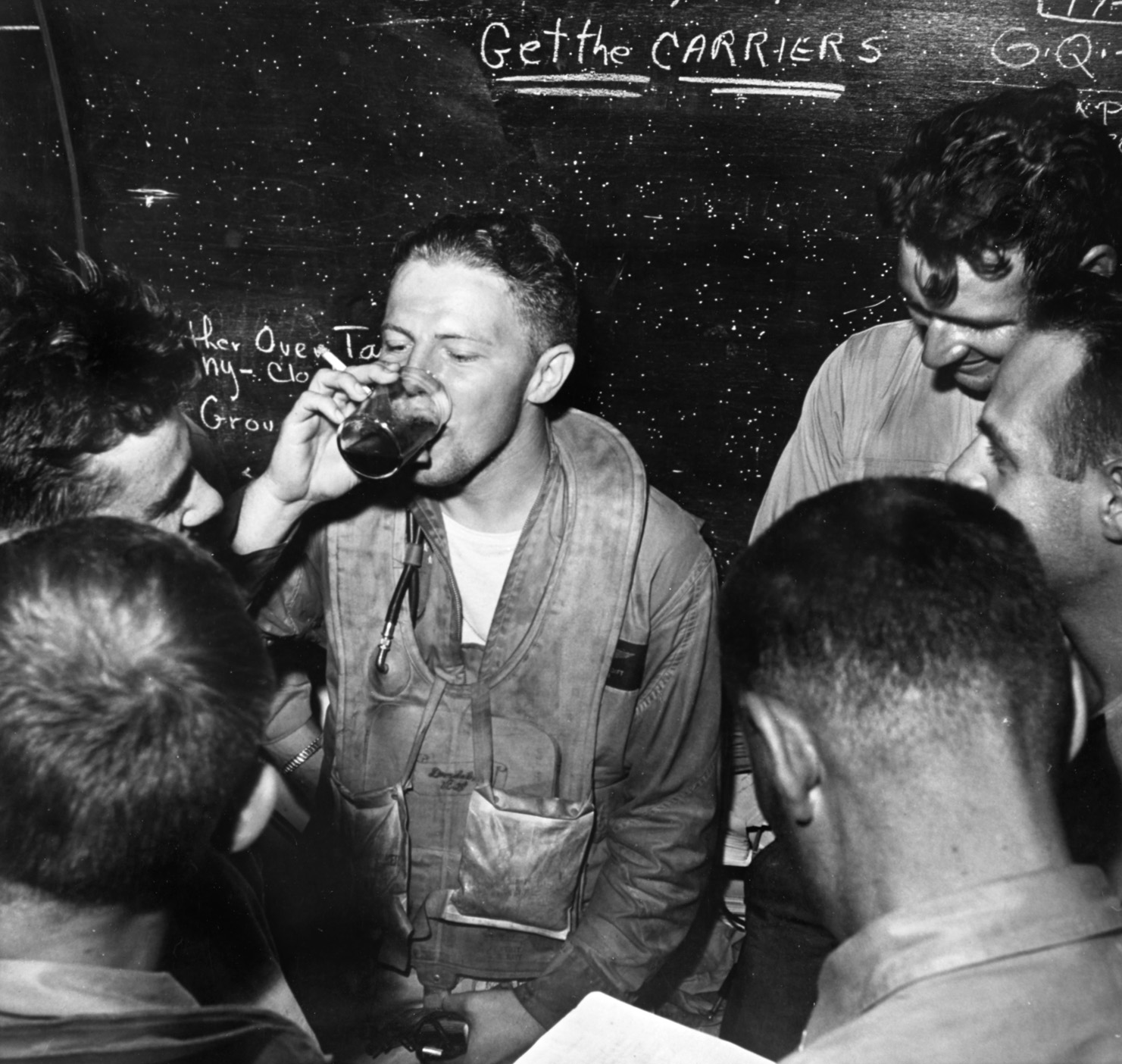
On Enterprise, night-fighter director Lt. Cdr. Richard E. “Chick” Harmer took off in his radar-equipped F4U Corsair to use its radar to find lost planes and lead them home. Harmer spent two hours guiding exhausted pilots home, along with Pete Aurand in his F6F from Bunker Hill. Following radio vectors, he used his radar to locate small groups of returning planes and guide them home.
Some aviators who reached TF 58, wearied from the long trip, made mistakes. They left gun switches on, didn’t watch their altimeters, and splashed into the water. Others flew non-standard landing patterns or crowded other planes out of the groove. Some were wounded. Landings began at 8:45 PM and continued until about 10:52. As the planes approached the carriers, pilots called their home carriers for landing instructions. They were told, “Land on any base.”
Some planes reached carriers, only to encounter disaster in the final seconds. A Hornet SB2C ignored a wave-off from Bunker Hill—which included a warning flare—and dropped onto the deck, flipping tail over nose and slashing its propeller into the wooden flight deck. A Cabot TBF behind it on final approach ignored a wave-off, smacked down off-center, snagged a gun turret, knocked down six men working on the SB2C, and killed three, including Bunker Hill’s air officer.
On Lexington, Commander Jimmie Thach, who had invented America’s fighter tactics to cope with the Zero back in 1942, studied the crisis carefully, making notes on improving the recovery efforts both now and in the future. He recommended to Burke that the carriers separate and illuminate themselves “like an airport runway.”
Overhead, the normally tight and proud formations disintegrated as the planes returned. Enterprise recovered 17 planes—seven from its own task group and 10 from other task groups. Lieutenant Horace “Hod” Proulx, an outstanding LSO, broke the rules he had been taught by his outstanding predecessors, cutting landing intervals thin from 30 to 15 seconds apart. Proulx got a Hellcat aboard on the No. 5 wire, but Lt. (j.g.) Cecil R. Mester had fuel for only one pass at the deck. Proulx got him on the number three wire.
Alex Vraciu also had a hard time coming home. He headed back to Lexington alone, aware of the common myth: “Fighter pilots can’t navigate.” He set his fuel mixture to “max conserve” and plodded along until he heard the “dit-dah” in his headphones for Lexington. Vraciu checked his fuel gauge, decided he had time, and waited. He wound up landing on Enterprise. He now had 19 kills.
A total of 226 planes had launched from Mitscher’s flight decks on the 20th, and 140 of those were back on one flight deck or another now. But 172 pilots and airmen remained stranded across a stretch of ocean as search and rescue efforts began immediately with TF 58 headed directly along the route the planes had taken. Two dozen ships, including four light cruisers, pulled 90 pilots and airmen out that night, all of whom were happy to trade their flight gear (souvenirs for the rescuers) for medicinal alcohol, dinner, and a warm bunk.
As dawn rose on TF 58 on June 21, everybody was beat. Mitscher himself cut everyone possible loose to get some sleep, which wasn’t easy—wartime-staffed ships required enlisted and officers to “hot-bunk,” which meant that two or three men shared a rack in tight sequence. Worse, many of the ships were poorly ventilated by design or due to being locked down during the battle, and the intense Pacific heat made compartments incredibly hot.
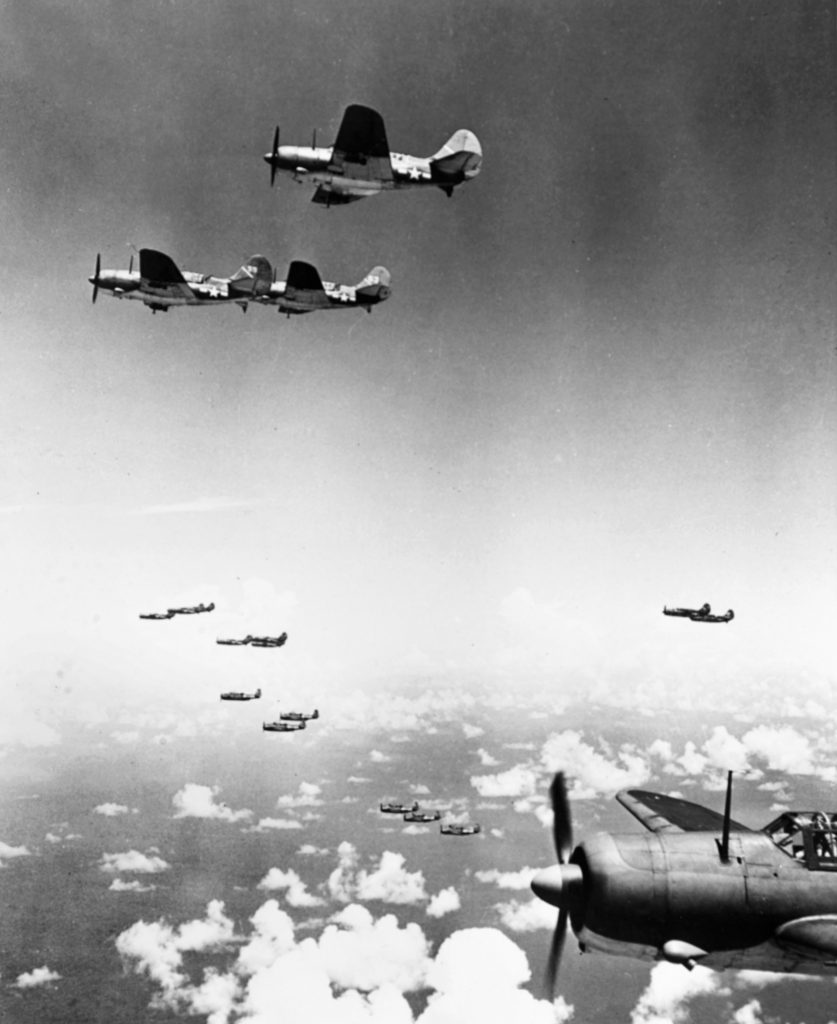
There was no chance now that TF 58’s carrier planes or battleships could catch up with the Japanese, who were fleeing at a high rate of speed. At 8:30 PM, Spruance ordered Mitscher to call off the chase 600 miles west of Saipan and head back to the island to support the invasion with guns and planes.
Meanwhile, Ozawa’s ships arrived at Nagakasuku Bay, Okinawa, which Americans would a year later rename Buckner Bay after invading the island. Ozawa now faced two major facts of defeat: sorting out the sunken ships’ survivors, and preparing his report for Toyoda in Tokyo. The former was easy enough; most went to Zuikaku or Maya to head for hospitals in Japan.
The second part took time. Ozawa claimed to have sunk or damaged four to five American carriers and a battleship, along with splashing 160 American planes. Actual American losses: no ships, 42 aircraft, 76 fliers, 31 sailors. Despite these exaggerated claims, it was clear that Ozawa had failed. He had lost 446 planes with 445 pilots and aircrew, and three aircraft carriers. The Imperial Japanese Navy still had nine carriers ready or nearly ready for action, but neither pilots nor planes. When four of the survivors of the Philippine Sea reappeared at Leyte Gulf in October, it would be purely to act as decoys, which they did perfectly, while being sunk.
Ozawa offered his resignation after the defeat, but Toyoda said, “I am more responsible for this defeat than Admiral Ozawa, and I will not accept his resignation.” There was now nothing Japan could do to save the beleaguered Marianas Islands defenders, and the islands would fall, taking with them the government of Prime Minister Hideki Tojo. Vice Admiral Shigryoshi Miwa, one of the Emperor’s closest advisers, warned that the loss of the Marianas meant that the sacred homeland would now be open to massive and destructive aerial bombardment. His admonition said it all: “Hell is upon us.”
There was recrimination on the American side, too. Mitscher himself said it simply: “The enemy escaped. He had been badly hurt by one aggressive carrier strike, at the one time he was within range. His fleet was not sunk.” Aviation officers in Hawaii blamed that on Spruance, a non-aviator, being put in command of carriers, pointing out that the great naval theorist Alfred Thayer Mahan himself had said that the main object of a fleet was to destroy the enemy’s fleet.
But Spruance, all his life, would defend his actions.
In his cabin onboard the battleship Yamato, Admiral Matome Ugaki, who commanded the 1st Battleship Division, reflected on the recent sea fight in the comprehensive diary he kept through the war, ending the day’s entry with a poem:
Utterly awakened from the dream of victory,
Found the sky rainy and gloomy.
Rainy clouds will not clear up,
My heart is the same
When the time for the battle’s up.
Author David Lippman resides in New Jersey and writes frequently on a variety of topics for WWII History. This is the second of a two-part article on the Battle of the Philippine Sea.
